Polymetric expressions are the basic representation model for the timing of musical data in the Bol Processor. Its versatility makes it ideal for use in computer music environments across many cultures. The word is a mixture of polyphony and polyrhythm, the former evoking superimposed streams of musical events, and the latter a metric adjustment of their durations.
This page illustrates the syntax of simple expressions and their interpretation by the polymetric expansion algorithm described in Two algorithms for the instantiation of structures of musical objects (Bel 1992). This process can be extremely complex, since an entire musical work — e.g. Beethoven's Fugue in B flat major — is treated by the Bol Processor as a single polymetric structure: see example.
In this tutorial, simple notes ("C4", "D4" etc.) are used following the "English" convention. All time-setting processes could be illustrated using sound-objects or simple notes in other conventions: "Italian/Spanish/French" or "Indian".
Symbolic versus physical duration
Music notation systems (for humans) make use of symbolic rather than physical durations. Their units are beats rather than (milli)seconds.
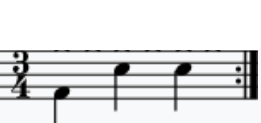
in western conventional music notation
In western conventional music notation, notes and pauses are represented by special signs indicating their relative durations.
For example, if the time signature is 3/4, we will have 3 quarter notes (crotchets) in a bar (see picture). A half note (minim) lasts twice as long as a quarter note in the same context. Other relative durations are expressed in the same way.
To get the physical duration of a note we need an additional piece of information: the metronome value, for example "mm = 100", which means 100 beats (quarter notes) per minute.
A metronome value (60 bpm by default ) is declared in the settings file of a Grammar or Data page. With this setting, note "E4" on a Bol Processor score represents an "E" of the 4th octave played in 1 beat with a physical duration of 1 second.
This convention extends to arbitrarily named sound-objects whose default durations are set by the streams of MIDI events or sequences of Csound instructions from which they are composed. The mapping of symbolic to physical time for the performance of sound-object structures (with their metric and topological properties) is a sophisticated process performed by a time-setting algorithm. A practical example is discussed on the page Interactive improvisation with sound-objects.
Polymetric expression
Typical forms of polymetric expressions are:
- field 1, field2 or {field 1, field2} indicates that field1 and field2 should be superimposed and the total symbolic duration should be adjusted to that of field1;
- field1 • field2 or {field1 • field2} indicates that field1 and field2 should be consecutive and the symbolic duration of each field should be adjusted to that of field1;
- {expression} is equivalent to expression.
Curly braces '{' and '}' are used to create multi-level expressions.
➡ Periods written as bullets '•' in the Data and Grammar windows are converted to plain periods before being sent to the console, as the console rejects some Unicode characters.
For example, {C4 D4, E4 F4 G4, E5} produces the following time structure with a metronome set to 60 beats per minute:
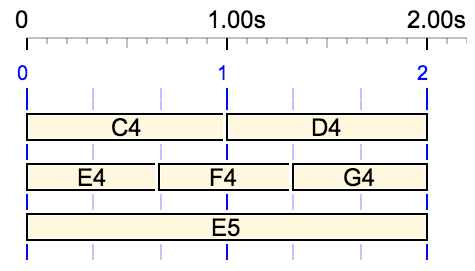
The duration is 2 beats, as set by the first field "C4 D4"
The use of the first field to set the total duration is highlighted by the following examples where the fields appear in a reverse order:
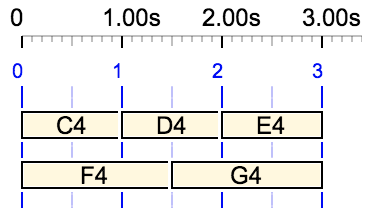
Duration of 3 beats
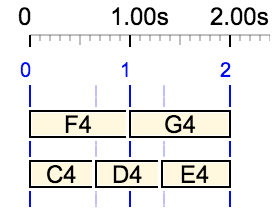
Duration of 2 beats
Rests (silences) can be notated with "-" for single unit rests, or with integer numbers and ratios. The following shows a single unit rest and a more complex rest of 2.5 beats:
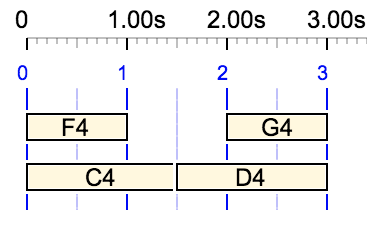
Duration of 3 beats
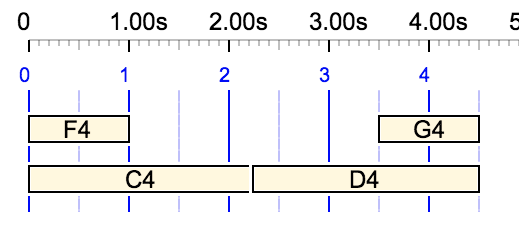
Duration of 4.5 beats
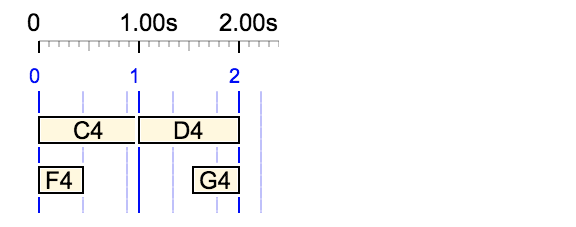
Duration of 2 beats
Polymetric structures can be multi-level, for example:
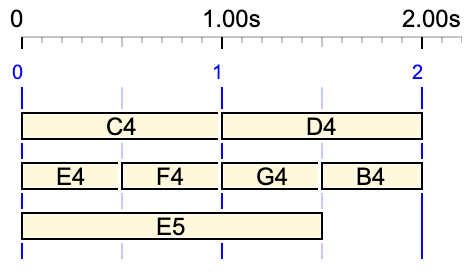
{C4 D4, {E4 F4 G4, E5} B4}
The same time-setting rules apply to sequences where commas are replaced by periods. For example:

Duration is set by that of the first field "F4 2 1/2 G4"
= 4.5 beats applied to the second field
Superpositions and sequences can be combined (even in multi-level expressions), such as:

Duration of 9 beats = twice that of "F4 2 1/2 G4"
Undetermined rests
Undetermined rests are a powerful feature of polymetric expressions, saving humans from the inconvenience of complicated time computations. This is an important step towards minimising the amount of numerical/symbolic information needed to create a precise temporal structures in music.
The polymetric expansion algorithm calculates (symbolic) durations that produce the least complex expression.
Undetermined rests are notated as "…" or "_rest" in Data or Grammars.
👉 Since the Bol Processor console does not recognise the "…" Unicode symbol, the PHP interface rewrites it as"_rest".
The examples below are based on superimposed structures, in which fields are separated by commas. The same expansion algorithm applies to sequential structures, where fields are separated by periods. All examples can be checked on the "-da.tryRests" page.
The same process is applied to structures containing sound-objects and/or simple notes. Here, we use simple notes for the sake of clarity.
Let us start with a trivial example. In {C4 D4 E4, … F4 G4}, the undetermined rest "…" is replaced by a single unit rest:
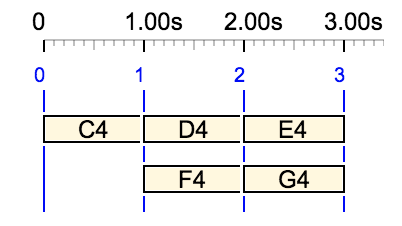
= {C4 D4 E4, _rest F4 G4}
Thus, the expression {C4 D4 E4, … F4 G4} is equivalent to {C4 D4 E4, - F4 G4} or {C4 D4 E4, 1 F4 G4}.
A similar sequential structure {C4 D4 E4 • … F4 G4} yields the following solution:

This solution gives the simplest polymetric expression. The same simple case is that of {… C4 D4 E4, F4 G4}:
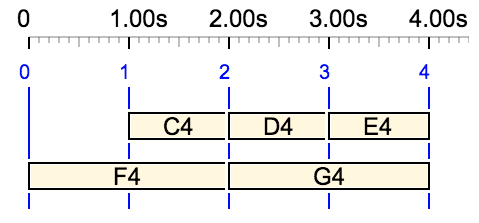
= {_rest C4 D4 E4, F4 G4}
If a field of the polymetric expression contains several undetermined rests, these are assigned equal durations — in such a way that the complexity of the structure remains minimal.
For example, consider {… C4 D4 … E4, A4 F4 G4}:
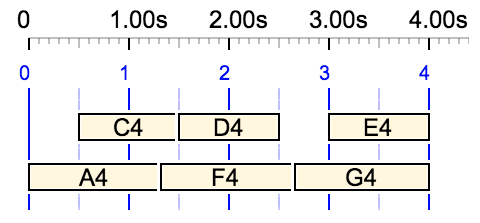
= {_rest C4 D4 _rest E4, A4 F4 G4}
Thus, this structure is equivalent to {1/2 C4 D4 1/2 E4, A4 F4 G4}.
An undetermined rest cannot be assigned duration 0, even when this would result in a simpler expression. For example, in {… C4 D4 … E4, F4 G4} duration 0 would result in a "three in two" polyrhythm, whereas duration 1/2 results in "five in two":
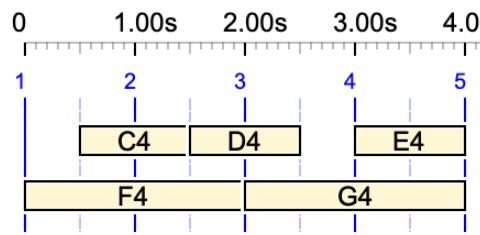
👉 The rejection of null durations has been implemented in December 2025 (version 3.3.6).
Each field of a polymetric expression can contain undetermined rests. Consider for example {… C4 D4 E4, A4 B4 F4 … G4}. Once again, assigning a duration of zero to each undetermined would result in the simplest structure, since "four in three" (LCM = 12) is a better trade-off than "five in four" (LCM = 20). However, but this null duration is not accepted:
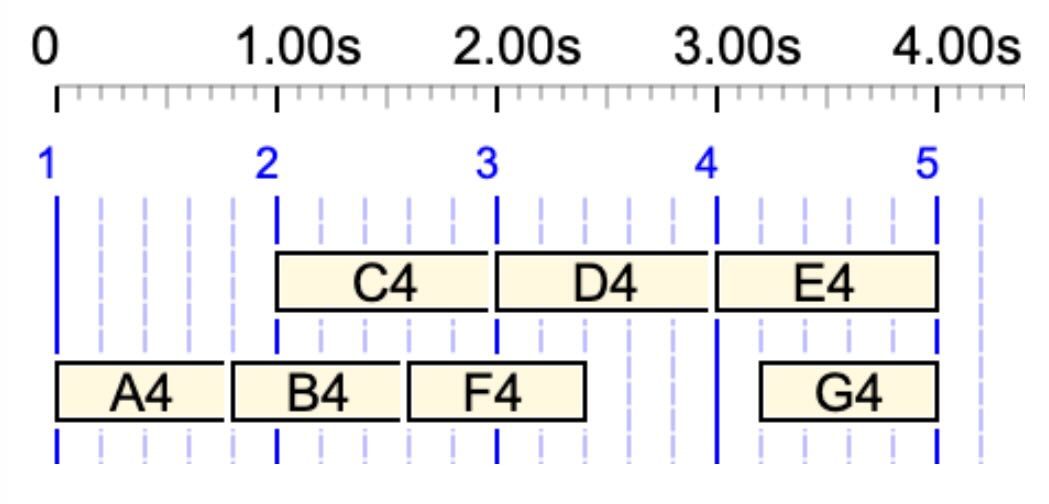
A more complex structure is assigned to {C4 D4 E4, A4 B4 F4 … G4 A4, C5 … D5} with rests of 1 unit in the second and third fields. The LCM of 3 and 6 is 6, which is the lowest value possible for this structure.
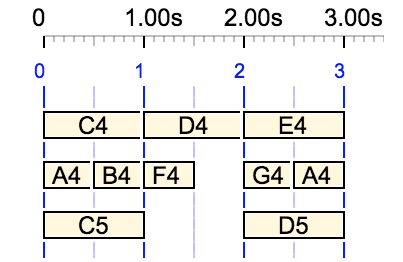
A similar case is {C4 D4 E4, A4 B4 F4 … G4 A4, C5 … D5 E5}:
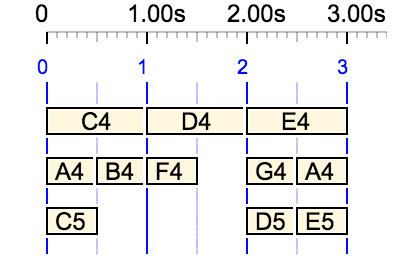
Here, the first rest has been assigned 1 unit and the second one 3 units. This gives the LCM of 3 and 6 = 6.
Replacing commas with periods gives the same structure in a sequential form:

= {C4 D4 E4 • A4 B4 F4 _rest G4 A4 • C5 _rest D5 E5}
Duration of the first field "C4 D4 E4" is applied to the 2nd and 3d ones
which results in a final count of 3 x 3 = 9 beats
Remember that the first field of a polymetric structure is the one that sets up its tempo (and global duration). Thus, replacing {C4 D4 E4, A4 B4 F4 … G4 A4, C5 … D5 E5} with {C5 … D5 E5, C4 D4 E4, A4 B4 F4 … G4 A4} sets the duration to 6 beats instead of 3, even though relative durations are unchanged:
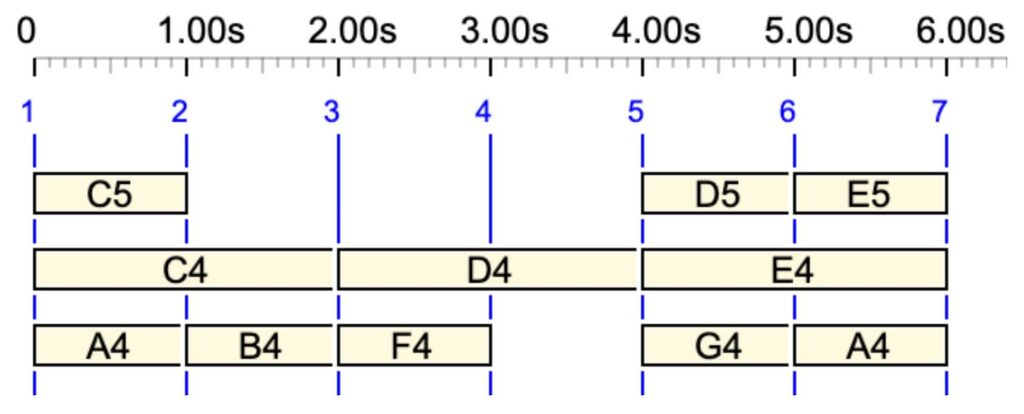
= {C5 _rest D5 E5, C4 D4 E4, A4 B4 F4 _rest G4 A4}
A more complicated case is {C4 D4 E4, A4 B4 F4 … G4 … A4 …, C5 … D5 … E5 …} in which the gaps are divided into 3 equal time periods:
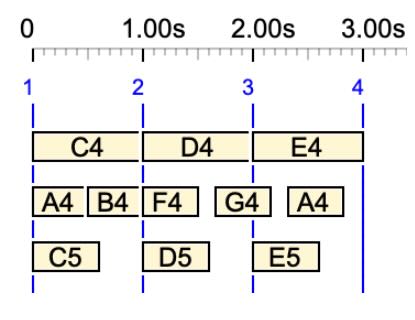
= {C4 D4 E4, A4 B4 F4 _rest G4 _rest A4 _rest, C5 _rest D5 _rest E5 _rest}
A notation of the former structure with explicit duration rests would be:
{C4 D4 E4, A4 B4 F4 1/3 G4 1/3 A4 1/3, C5 - D5 - E5 -}
Undermined rests can be processed in multilayer structures, for example {A3 … B3 C3, {C4 D4 E4, … F4 … G4}} which yields:
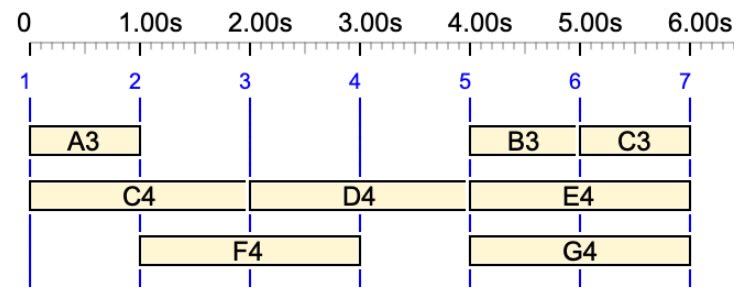
= {A3 _rest B3 C3, {C4 D4 E4, _rest F4 _rest G4}}
These structures can be a mixed of superimposed and sequential structures. For example, {A3 … • B3 C3, {C4 D4 E4, … F4 … G4}} yields:
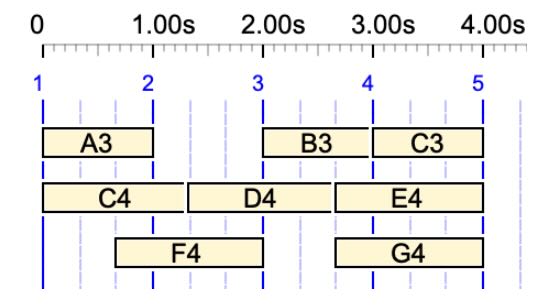
{A3 … • B3 C3, {C4 D4 E4, … F4 … G4}}
= {A3 _rest • B3 C3, {C4 D4 E4, _rest F4 _rest G4}}
Minimised polymetric expression
A polymetric expression is minimised by replacing quantified rests with undetermined rests wherever possible, without losing accuracy. An algorithm has been implemented (version 3.3.6 of December 2025) to minimise the samples used for training an AI to translate a MIDI stream into its equivalent polymetric expression (read the AI recognition of polymetric notation page).
The process is shown in detail on project "-da.tryMinimise". Click the MINIMIZE button to minimize all structures on this page, and Undo MINIMISE to delete the minimised version. Items can be played and displayed to verify that they are identical to their minimised versions.
Read the page Minimising a polymetric structure for a detailed explanation of this process.
Tied notes, tied sound-objects
Sound-objects or simple notes can be concatenated ("tied"). Consider, for example:

and its variation with ties notated "&":

The time interval of a tied note/sound-object may cross the limits of (tree-shaped) polymetric structures. For example:
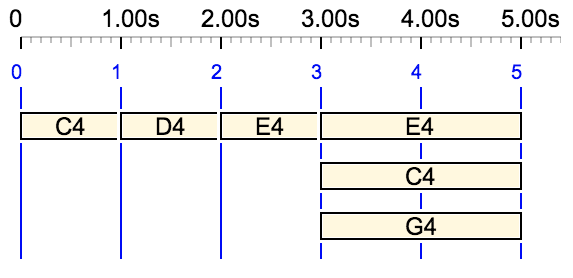
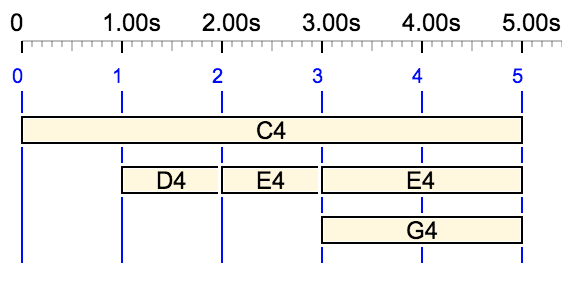
The challenge of dealing with tied events is discussed on the Tied notes page.
Real music is “polymetric”
The rules and heuristics associated with polymetric expressions make sense when dealing with real musical items. In particular, they made it possible to import MusicXML scores and interpret them as Bol Processor data — read the Importing MusicXML scores page.
For example, check out Mozart’s musical dice game, this "Charles Ames" example and Harm Visser's demos.
Further reading
Bel, Bernard. Rationalizing musical time: syntactic and symbolic-numeric approaches. In Barlow, Clarence (ed.) The Ratio Book. Den Haag: Royal Conservatory - Institute of Sonology. 2001: 86-101.
Bol Processor shares a few features, with respect to pattern representation, with the TIDAL Pattern Language for the Live Encoding of Music (Alex McLean & Geraint Wiggins, 2010):
An Indian conception of time can be seen most clearly in the venerable Bol Processor system for algorithmic music, created by computer scientist Bernard Bel from work on notating tabla rhythms and developed over forty years. Drawing from Indian classical music, it includes an expressive approach to time setting that seems unique to the algorithmic music field, in which sound events are organized in terms of interrelationships before being mapped to physical time. Although not a live coding system itself, it has been heavily influential on the design of the TidalCycles system, particularly its embedded “mininotation” language for describing rhythm in the Bol Processor and more generally its representation of music based not on the duration of events (as in staff notation) but on the duration of cycles.
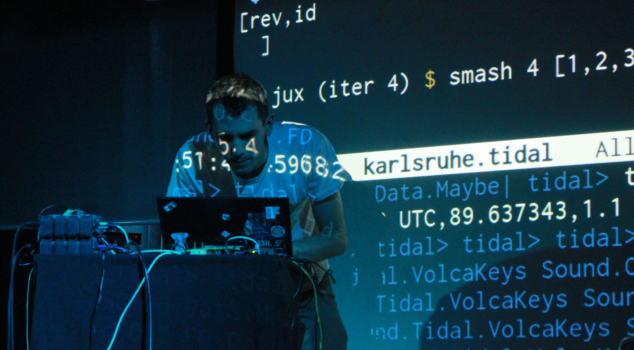
Alan Blackwell, Emma Cocker, Geoff Cox, Thor Magnusson, Alex McLean, Live Coding: A User's Manual, MIT 2022, page 195.
